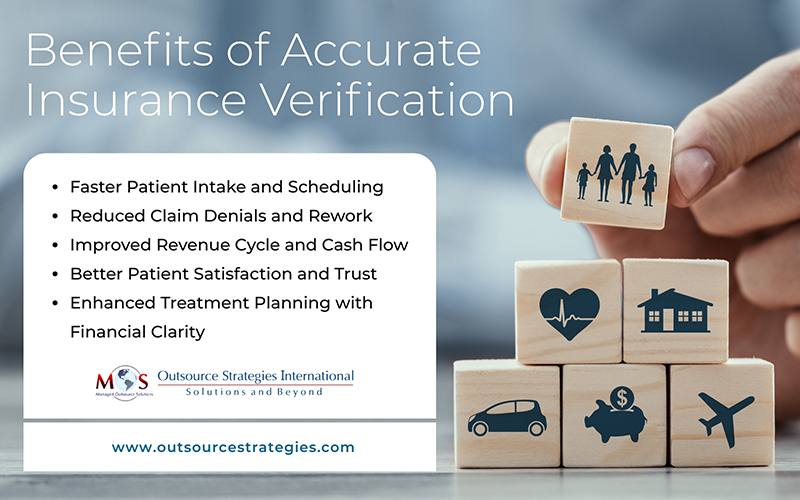As dental practices strive to provide high-quality care, they face various challenges such as financial management, staffing issues, technology integration, and patient retention. Among these, verifying dental insurance eligibility, the primary step to determine whether a patient is covered for a treatment or not, stands out as a critical yet often overlooked process. Time-consuming insurance checks can significantly disrupt daily workflow, causing scheduling delays and leading to patient dissatisfaction.
While often considered just another administrative task, verifying insurance eligibility is the foundation of a smooth revenue cycle and a positive patient experience. When done accurately and efficiently, it ensures timely payments, minimizes claim denials, and builds patient trust. But when overlooked or rushed, it can lead to billing issues, treatment delays, and frustrated patients. As verifying dental treatment coverage is a challenging process, many practices prefer to outsource it to companies that are specialists in the field.
Optimize your dental billing process
outsource your insurance verification to our experts today
What Is Dental Insurance Verification?
Dental insurance verification is the process of confirming a patient’s insurance coverage and benefits before treatment, preventing unexpected costs and claim denial. What typically verified:
- Effective Date: When the patient’s benefits begin—important to confirm that coverage is active on the date of service.
- Coverage Percentages: How much of a specific procedure the insurance plan will cover, usually expressed as a percentage (e.g., 100% preventive, 80% basic, 50% major).
- Plan Limitations: Restrictions on what services are covered, how often they can be performed, and the extent of coverage (e.g., frequency limits, waiting periods, exclusions).
- Deductible: The amount the patient must pay out of pocket each year before the insurance starts covering dental expenses.
- Copays: The fixed amount the patient pays at the time of service, depending on the procedure and plan type.
- Coinsurance: The percentage of a procedure’s cost that the patient must pay after the deductible is met and the insurance has paid its share.
- Maximum Out-of-Pocket Expenses: The most a patient will pay in a plan year for covered services—including deductibles, copays, and coinsurance. After this limit is reached, the insurance typically covers 100% of remaining covered expenses for that year.
- In- or Out-of-Network: This refers to verifying whether the dentist providing the services is in-network with the patient’s insurance plan.
It essential that dental practices verify a patient’s insurance coverage before providing treatment. This can typically be done by logging into the insurer’s portal or calling the toll-free number listed on the patient’s ID card. However, the American Dental Association (ADA) cautions that this information may not always be up to date. In some cases, the patient’s dental plan may not have received timely notification from the employer about changes such as termination of employment or benefits. This means that even if the portal or call center confirms active coverage, the information may be inaccurate.
To avoid surprises, dental offices should also verify eligibility on the day of the appointment by speaking directly with the patient. Front desk staff should ask questions such as:
- Has your dental insurance changed since your last visit?
- Have you or the policyholder experienced any employment changes recently?
- Do you know how long your dental coverage will remain active following the change in employment?
- Did your employer provide any documents related to changes in your benefits?
By proactively verifying coverage at each visit, practices can reduce denied claims, improve billing accuracy, and maintain patient trust.
Why It Matters: Benefits of Accurate Insurance Verification
Accurate insurance verification contributes to a dental practice’s success in many ways:
Faster Patient Intake and Scheduling
When insurance is already verified, it reduces staff time spent on collecting information or making last-minute calls. Patients can check in and get treatment faster. Knowing what services are covered ahead of time helps staff schedule procedures appropriately, avoiding delays due to benefit restrictions or financial uncertainties. Patients are more likely to keep appointments when they know their coverage is active and what their out-of-pocket costs will be, reducing no-shows and last-minute rescheduling. When coverage is verified, patients can be provided with clear, upfront cost estimates. This transparency speeds up both financial discussions and consent for treatment. With insurance confirmed, the dentist can focus on care delivery.
Reduced Claim Denials and Rework
Without thorough dental insurance verification, practices risk submitting claims that may be denied due to patient ineligibility or outdated information. Verifying insurance details in advance ensures that claims are submitted with complete, accurate, and current details, significantly reducing the chances of rejection. By proactively confirming coverage, dental offices can minimize costly and time-consuming rework, helping maintain steady cash flow and reducing delays in reimbursement.
Improved Revenue Cycle and Cash Flow
With accurate information submitted the first time, claims are processed more quickly, leading to faster payments—eliminating delays caused by errors or missing details. This leads to an improved revenue cycle and helps maintain a healthy cash flow for the dental practice. Timely payments also reduce the need for follow-ups with payers and free up staff to focus on patient care rather than correcting administrative errors.
Better Patient Satisfaction and Trust
Insurance checks helps patients understand what their insurance covers and what they need to pay. Surprise dental bills can be a major source of stress for patients. When your practice clearly communicates expected costs before treatment, it builds trust and improves the overall patient experience. On the other hand, frequent errors in insurance verification and billing can damage your practice’s reputation. Patients may lose confidence, leading to lost retention and missed opportunities to attract new patients.
Enhanced Treatment Planning with Financial Clarity
When insurance is verified in advance, the dentist can create a treatment plan in keeping with the patient’s coverage and budget. When the dental team has the right information — what procedures are covered, the percentage paid by insurance, and any out-of-pocket costs – they can present clear, affordable options to the patient. This clarity supports better decision-making and reduces treatment delays due to financial uncertainty.
For example, if a patient needs a crown, verifying insurance may reveal that the plan covers 50% of major restorative work, but the patient has already used part of their annual maximum. With this information, the practice can offer a phased treatment plan or discuss financing options – helping the patient proceed with confidence and fewer financial surprises.

Common Challenges in Dental Insurance Verification
Challenges in verifying insurance benefits and coverage can lead to delays, billing errors, and denied claims, all of which negatively affect practice cash flow and patient satisfaction. Common challenges of insurance checks in dental practices include:
- Time-consuming insurance checks: Verifying benefits manually can slow down front-desk operations and extend patient wait times.
- Manual errors and outdated information: When data is inaccurate or incomplete. It can lead to claim denials and billing issues.
- Coordination issues with insurance carriers: Delays in getting responses from insurers can delay treatment approvals and disrupt scheduling.
- Staff training and workload: Lack of proper staff training and work overload can result in missed verification steps and unreliable processes.
- Last-minute surprises for patients: If coverage is not verified correctly, patients may face unexpected costs at checkout, causing dissatisfaction and loss of trust.
Without accurate, timely verification, treatment may be postponed, patients may receive unexpected bills, and staff may spend valuable time reworking claims – all of which disrupt the smooth operation of the practice.
Enhancing the Accuracy Dental Insurance Checks: Key Considerations
Determine the Effective Coverage Date
The effective coverage date marks when a patient’s dental insurance benefits begin. From this date, the insurance provider agrees to pay for eligible dental treatments. It’s important to note that many dental plans include a waiting period for certain procedures – typically major services like crowns or bridges. During this time, claims for these treatments may be denied. Verifying the effective date and any applicable waiting periods upfront helps prevent claim rejections and treatment delays.
Verify the Annual Maximum Coverage Limit
Once the annual maximum coverage limit is reached, the patient is responsible for 100% of any additional treatment costs. If a patient is close to or has exceeded this cap, it’s important to discuss this during the verification process to avoid financial surprises and support informed decision-making.
Identify the Patient’s Deductible
Deductibles reset annually and can vary for individuals and families. Since many patients don’t fully understand how their deductible works, it’s essential to explain their financial responsibility during the verification process. This transparency helps build trust and reduces the likelihood of billing disputes.
Understand the Standard Coverage Percentages
Coinsurance comes into play after the deductible is met. This is the shared cost between the insurer and the patient, typically expressed as a percentage (e.g., 80/20). While most plans fully cover preventive care, basic and major procedures usually involve coinsurance. Verifying the coverage percentage for the planned treatment ensures the patient knows what portion they’ll need to pay, helping avoid confusion at the time of billing.
Check Frequency Limitations
Dental insurance often restricts how often a procedure can be performed within a year. For example, if a plan covers only two cleanings per year, a third cleaning may not be reimbursed. Always verify frequency limits for preventive and other recurring services to help patients avoid denied claims and manage their care effectively.
Confirm Age-Related Restrictions
Dental insurance plans may stop covering dependents under a parent’s plan once they turn 26. Additionally, specific treatments may have age limits—for example, orthodontic benefits may only apply up to age 18, while fluoride treatments might be covered only up to age 16. These age-related restrictions should be verified to ensure accurate coverage and patient guidance.
Watch for Downgrades
Some insurance plans cover only the least expensive treatment option when multiple options are available. This is known as a downgrade. For example, a plan might cover a silver amalgam filling even if a composite filling is used. It’s critical to inform patients of such limitations and document their consent if they choose a downgraded option. Some in-network plans may even require a signed downgrade acknowledgment form.
Why Outsourcing Patient Eligibility Checks is A Winning Strategy
Conducting dental insurance eligibility checks in-house requires extensive staff training and attention to detail. Outsourcing this task to experienced professionals can ensure implementation of best practices, significantly improving claim accuracy and streamlining the dental billing process. Specialists in dental insurance verification utilize real-time tools and confirm benefits at least 48 hours in advance. They also help ensure proper documentation and record-keeping, supporting successful and timely reimbursement.
Learn how our dental insurance checks reduce claim errors and improve patient satisfaction!




